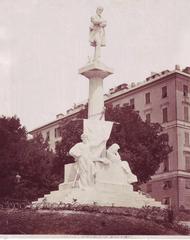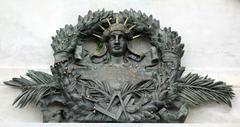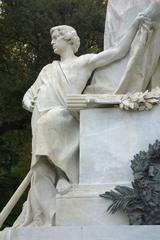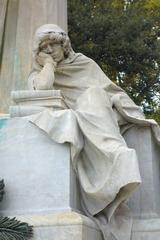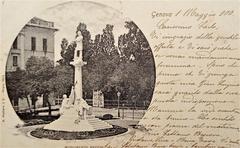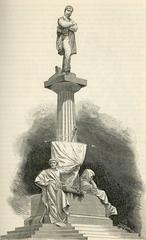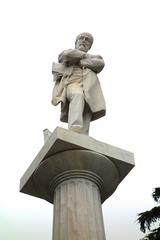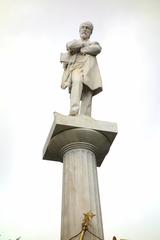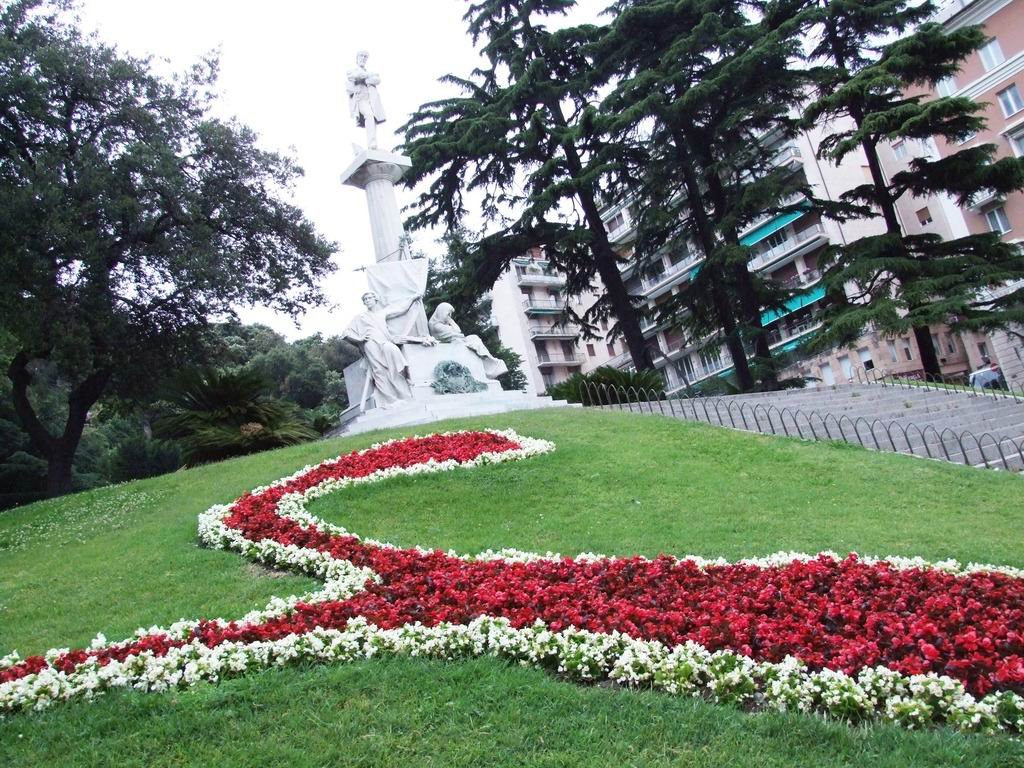
Visiting the Monument to Giuseppe Mazzini in Genoa, Italy: Tickets, Hours, and Tips
Date: 14/06/2025
Introduction
The Monument to Giuseppe Mazzini in Genoa stands as a powerful testament to one of Italy’s most influential patriots and thinkers. Situated in the heart of Genoa’s historic center, this striking neoclassical monument is a must-see for anyone interested in Italian history, the Risorgimento, or Genoa’s rich cultural heritage. This guide provides detailed information about the monument’s historical significance, artistic features, visiting hours, accessibility, and practical travel tips to ensure you make the most of your visit.
For the latest visitor information, refer to official resources such as Visit Genoa and Musei di Genova.
Table of Contents
- Historical Background
- Artistic and Symbolic Features
- Visiting Information: Hours, Tickets, and Accessibility
- Nearby Cultural Attractions
- Practical Tips for Visitors
- Frequently Asked Questions (FAQ)
- Conclusion
- References
Historical Background
Giuseppe Mazzini: Life and Legacy
Giuseppe Mazzini (1805–1872) was born in Genoa to a middle-class family. Early exposure to political ideas and university studies shaped his commitment to Italian unity and republican ideals. Mazzini joined the Carbonari, a secret society advocating constitutional reform, and later founded Giovine Italia (Young Italy) in 1831 to promote the creation of a united, free, and republican nation. He played a critical role in the Risorgimento, Italy’s movement for national unification, inspiring generations of patriots and influencing European political thought (Visit Genoa; Arktos Journal; General History).
Origins of the Monument
After Mazzini’s death in 1872, Genoa sought to honor his legacy by erecting a monument in his birthplace. The project was conceived in the late 19th century, during a period of national consolidation and commemoration of Risorgimento figures. The monument was designed to symbolize the values Mazzini championed—liberty, unity, and republicanism—and to reinforce Genoa’s pivotal role in Italian unification (Musei di Genova).
Artistic and Symbolic Features
The Monument to Giuseppe Mazzini features a larger-than-life bronze statue of Mazzini in a contemplative pose, highlighting his role as a visionary thinker. The neoclassical design includes a substantial stone pedestal adorned with bas-reliefs and inscriptions referencing key moments in Mazzini’s life, such as the founding of Young Italy and his involvement in the Roman Republic of 1849.
Surrounding the central figure are allegorical representations of Liberty and the Italian Nation, as well as national symbols like the Italian flag and laurel wreaths. These elements reinforce the monument’s message of patriotism and unity. The monument’s setting in a prominent public square integrates it into Genoa’s urban and cultural landscape (Musei di Genova; Wikimedia Commons).
Visiting Information: Hours, Tickets, and Accessibility
Hours and Admission
- Monument Access: Open 24/7, located in a public square. No ticket required.
- Museo del Risorgimento—Casa Mazzini: Located nearby in Mazzini’s birthplace at Via Lomellini 11.
- Hours: Tuesday–Sunday, 10:00 AM – 6:00 PM; closed Mondays and public holidays.
- Admission: Free entry (Musei di Genova).
Accessibility
- The monument and surrounding square are wheelchair accessible, with flat, well-maintained streets.
- The Museo del Risorgimento is equipped with accessibility features for visitors with disabilities.
- Public restrooms and seating areas are available nearby.
Getting There
- By Metro: De Ferrari station on Metro Line 1 is a short walk away.
- By Bus: Multiple bus lines (18, 20, 34) stop at Piazza De Ferrari.
- By Train: Genova Piazza Principe and Genova Brignole stations are within 20 minutes’ walk or a short ride by public transport.
- By Car: Parking available at Parcheggio della Vittoria and other city center garages (evendo.com).
Nearby Cultural Attractions
- Museo del Risorgimento—Casa Mazzini: Exhibitions and guided tours on Mazzini and the Risorgimento.
- Galleria Giuseppe Mazzini: Historic shopping arcade with boutiques, cafes, and regular cultural events (visitgenoa.it).
- Rolli Palaces: UNESCO-listed aristocratic palaces nearby.
- Carlo Felice Theatre: Genoa’s major opera house.
- Via Roma and Caruggi: Prestigious shopping streets and medieval alleys.
A visit to the monument can easily be combined with these sites for a rich, immersive cultural experience (Italia.it).
Practical Tips for Visitors
- Best Time to Visit: Spring (April–June) and fall (September–October) offer mild weather and fewer crowds.
- Photography: Early morning or late afternoon provides the best light. Capture details of the monument’s bas-reliefs and surrounding arcades.
- Events: Annual commemorations on March 10 (Mazzini’s death) and June 22 (his birthday) feature ceremonies and guided tours.
- Language: Italian is spoken, but key tourist areas offer English information.
- Safety: Genoa’s center is generally safe; remain vigilant for pickpocketing in crowded spots.
- Dress Comfortably: Wear good walking shoes for cobblestone streets.
Frequently Asked Questions (FAQ)
Q: Is there an entry fee for the Monument to Giuseppe Mazzini?
A: No, it is a public outdoor site and free to visit at any time.
Q: What are the monument’s visiting hours?
A: The monument is accessible 24/7. The museum is open Tuesday–Sunday, 10:00–18:00.
Q: Are guided tours available?
A: Yes, especially for the Museo del Risorgimento and during commemorative events. Check with local operators or the museum.
Q: Is the area wheelchair accessible?
A: Yes, the monument and nearby museum are accessible for visitors with mobility challenges.
Q: What else can I see nearby?
A: The Rolli Palaces, Galleria Giuseppe Mazzini, Carlo Felice Theatre, Via Roma, and the medieval old town are all within walking distance.
Conclusion
The Monument to Giuseppe Mazzini is a profound symbol of Italy’s struggle for unity, freedom, and republican ideals. Its accessible, central location in Genoa and its integration with nearby historical and cultural sites make it an essential stop for travelers. Whether you are exploring alone, with family, or as part of a group, this monument invites reflection on the ideals that shaped modern Italy.
For more information, download the Audiala app for immersive guided tours and updates. Explore related posts on Genoa’s historical sites and follow us on social media to deepen your journey into Italy’s past.
References
- Visit Genoa: https://www.visitgenoa.it/it/giuseppe-mazzini
- Musei di Genova: https://www.museidigenova.it/en/mazzini-and-garibaldi-table
- Arktos Journal: https://arktos.com/2023/09/26/the-life-and-thought-of-giuseppe-mazzini-part-one/
- General History: https://general-history.com/mazzini-and-garibaldi/
- Guida di Genova: https://www.guidadigenova.it/en/museums-genoa/museum-of-risorgimento/
- Italia.it: https://www.italia.it/en/liguria/genoa/things-to-do/shopping-in-via-roma-and-galleria-mazzini
- Evendo.com: https://evendo.com/locations/italy/liguria/attraction/galleria-giuseppe-mazzini
- Wikimedia Commons: https://commons.wikimedia.org/wiki/Category:Monument_to_Giuseppe_Mazzini_(Genoa)
- World History Journal: https://worldhistoryjournal.com/2024/10/15/the-history-of-genoa-from-ancient-times-to-modern-day/
- Unansea: Giuseppe Mazzini Biography: https://en.unansea.com/giuseppe-mazzini-biography-and-interesting-facts-from-life/
- Whereandwhen.net: https://www.whereandwhen.net/when/europe/italy/genoa/

